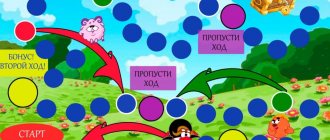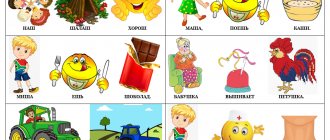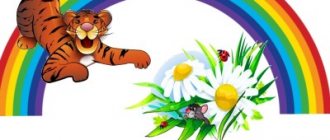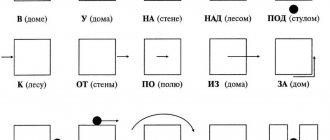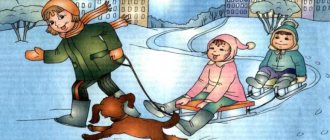A set of homework assignments for the sound “C” includes games and exercises for automating sounds in syllables, words, phrases, sentences, phrases, tongue twisters, texts and poems. The complex consists of 20 full-fledged classes. In them you will find verbal and visual material on practicing the sound “C” in all positions. Each activity also includes coloring pages to help develop fine motor skills.
The lessons are designed in black and white, but have links and QR codes to color visual material on the website logoped-online.by
Homework material is arranged from simple to complex. If your child has difficulty completing the current activity, then you should not proceed to the next one. It’s better to repeat it again and consolidate what you have previously learned.
Speech therapy puzzles.Having completed the puzzle, the child names the objects. The next task will be to come up with a sentence using each picture, or several at the same time. At the same time, visual perception develops.
“Help Shura decorate the Christmas tree.”
Goal: automation of sound Ш
Material: image of a Christmas tree, Christmas tree decorations with the image of the sound Sh.
Progress: the child helps Shura decorate the Christmas tree, saying words with the sound Ш.
Game "Who will fly on the rocket"?
Goal: development of phonemic hearing, automation [w].
Equipment: pictures of animals, image of a rocket.
Progress of the game: guys, our rocket is taking off, you need to find passengers with the sound [sh] and attach them to the rocket so that they can take off.
Exercise: “Cut pictures”
Goal: Development of constructive praxis, fine motor skills, thinking. Automation of sound Sh.
Progress of the game: The speech therapist asks the children to take them out of the envelopes
pictures and look at them. Invites children to collect
cut the pictures into pieces to tell what they did.
Depending on the capabilities of the children, the pictures can be cut into 3-6 parts and have horizontal vertical sections.
The forest is noisy
Target . Automation of sound w.
Description of the game. The teacher recalls with the child how in the summer they went to the forest and saw tall trees there, they had green tops, a lot of twigs and leaves. A breeze will come and sway the tops of the trees, and they will sway and make noise: shhhh...
The teacher invites the children to raise their arms up like branches of trees and make noise like trees when the wind blows on them: shhhh...
“Tell me what is shown.”
Goal: automation of the sound [ш] in sentences with the preposition “na” based on pictures.
Equipment: pictures (mouse on a potato, pine cone on the palm, bear on the path, cheesecake on a mug, etc., chips).
Progress of the game: guys, you need to turn the picture over and say what is shown on it, highlighting the sound [w]. If you name correctly, you get a chip.
"Snow Cloud"
Goal: automation of the sound Ш in words and sentences; development of attention
Material: image of a cloud with snowflakes, pictures with sound Sh.
Procedure: the child puts pictures with sound on the cloud, covering the snowflakes and calling out the words.
"Let's count the cars"
Goal: Activation of the dictionary on the topic. Agreement of numerals with nouns. Automation of the sound Ш in words.
If your child has toy cars, then invite him to count them: “One car, two cars... five cars.” You can complicate the task and count cars based on color or size: “One small car, two small cars... five small cars.”
If you don’t have cars, you can count them while walking.
"Squirrel reserves"
Goal: automation of hissing sounds.
Material: image of a squirrel, cones and mushrooms with pictures with hissing sounds.
Progress: the child names what supplies the squirrel has made.
Sound automation games [F]
Speech therapy puzzles.
Having completed the puzzle, the child names the objects. The next task will be to come up with a sentence using each picture, or several at the same time. At the same time, visual perception develops.
Exercise: “Cut pictures”
Goal: Development of constructive praxis, fine motor skills, thinking.
Progress of the game: The speech therapist asks the children to take them out of the envelopes
pictures and look at them. Invites children to collect
cut the pictures into pieces to tell what they did.
Depending on the capabilities of the children, the pictures can be cut into 3-6 parts and have horizontal vertical sections.
Exercise: “What do a Christmas tree and a hedgehog have in common?”
Goal: Getting to know homonyms. Automation of the sound Ж in words.
Progress of the game : The speech therapist suggests comparing two objects. Show what they have in common. The spruce looks like a hedgehog: the hedgehog is covered in needles, and so is the fir tree.
Game "Bugs"
Goal: to develop a long speech exhalation. Work on speech diction. Automation of the sound Ж in connected text.
Progress of the game: children (beetles) squatted down and said:
I'm a beetle, I'm a beetle
I live here,
I buzz, I buzz:
W-w-w-w.
At the teacher’s signal, the beetles fly into the clearing. There they fly, bask in the sun and buzz: w-w-w... at the signal “Rain” the beetles fly into the houses (chairs).
“BEETLE ON A FLOWER”
GOAL : Development of a strong long exhalation. Activation of the lip muscles. Clear articulation of the isolated sound “Zh”.
Progress: The speech therapist asks if the child knows any insects. He suggests planting a yellow beetle in the middle of the flower. Then he says:
I'm an angry yellow bug. I have six legs. I crawl and buzz, I buzz and crawl, Fast along the path. I'm circling over the lawn. I’m sitting on a chamomile: well - well - well.
The child clearly pronounces the sound “Zh” in words. Then, with a strong, long exhalation, they help the beetle fly away.
Sound automation games [Ш]
Exercise: “Cut pictures”
Goal: Development of constructive praxis, fine motor skills, thinking.
Progress of the game: The speech therapist asks the children to take them out of the envelopes
pictures and look at them. Invites children to collect
cut the pictures into pieces to tell what they did.
Depending on the capabilities of the children, the pictures can be cut into 3-6 parts and have horizontal vertical sections.
Game: “Bragging Animals”
Purpose: - Formation of nouns of subjective assessment using the suffix - isch; Automation of sounds in words.
Progress: For this game you will need two toy animals, for example a cat and a dog. The adult invites the child to play with the boastful animals, as if competing to see who is the best.
Sample: “I don’t have a cat, but a cat, he doesn’t have a mustache, but a mustache, etc.”
Game: “Giant Insects”
Goal: Use words with magnifying connotations. Drawing up proposals based on the model.
Progress of the game : The speech therapist gives an example of how to say about a large insect:
This is not a spider, but a spider.
This is not a mosquito, but a mosquito.
The child then independently makes sentences about the insect shown in the picture.
Didactic game in speech therapy work
Anna Romanchenko
Didactic game in speech therapy work
Didactic game in speech therapy work.
Everything with a child must be done through play...
D. B. Elkonin
Remember how the kids’ eyes light up, what impatient anticipation of something pleasant and joyful shines in them when you say: “And now you and I, guys, are going to play an interesting game!” here you don’t even need to be a subtle psychologist to understand what a huge and special place play occupies in a child’s life.
Therefore, one of the main tasks of a speech therapist is to interest the child so that he himself wants to participate in the process of speech correction. And for this purpose, classes should not be boring lessons, but an interesting game. A. S. Makarenko said: “The child has a passion for play, and it must be satisfied. We must not only give him time to play, but we must imbue his entire life with this game. His whole life is a game."
Play is the main activity of a preschool child, one of the characteristic patterns of child development. Play, as a form of child activity, contributes to the development of his mental processes, personality traits, and intelligence.
The Federal State Educational Standard for Preschool Education was developed for the first time in Russian history in accordance with the requirements of the Federal Law “On Education in the Russian Federation” that entered into force on September 1, 2013. And the main task of the Preschool Education Standard is to return play activities and the status of developmental play activities in kindergarten. After all, upbringing, development and learning takes place through play, and not forced play, but one that takes into account the abilities and interests of children; they teach the ability to communicate freely in a group of peers and to live comfortably in society.
Recently, the number of children with speech pathology has increased. In addition to the direct violation of sound pronunciation, children are diagnosed with violations of other components of the speech process: poor vocabulary, ungrammatical phrases, low level of development of coherent speech, etc. The mental basis of speech also suffers: attention, memory, thinking.
Thus, gaming technologies can provide great assistance in working with children with speech disorders.
Therefore, in speech therapy classes, didactic games are widely used (with objects, board-printed, verbal, games with movements, plot, role-playing games, dramatization games.
A didactic game is a game designed for learning. These are games with rules, specially created by pedagogy for the purpose of teaching and raising children.
A didactic game is a valuable means of cultivating mental activity; it activates mental processes and arouses a keen interest in the process of cognition in preschoolers. Alexander Vladimirovich Zaporozhets, assessing the role of the didactic game, emphasized: “We need to ensure that the didactic game is not only a form of assimilation of individual knowledge and skills, but also contributes to the overall development of the child.”
There are several types of didactic games:
Travel games are designed to enhance the impression and draw children’s attention to what is nearby. They sharpen observation and demonstrate overcoming difficulties. These games use many ways to reveal cognitive content in combination with gaming activities: setting problems, explaining how to solve them, solving problems step by step, etc.
Games - instructions are simpler in content and shorter in duration. They are based on actions with objects, toys, and verbal instructions.
Games are speculation (“what would happen if…”). Children are given a task and a situation is created that requires comprehension of the subsequent action. At the same time, children’s mental activity is activated, they learn to listen to each other.
Games are riddles. They are based on testing knowledge and resourcefulness. Solving riddles develops the ability to analyze, generalize, and develops the ability to reason and draw conclusions.
Games - conversations. They are based on communication. The main thing is spontaneity of experience, interest, and goodwill. Such a game makes demands on the activation of emotional and mental processes. It develops the ability to listen to questions and answers, focus on the content, supplement what is said, and express judgments.
The didactic game has its own structure, which includes several components. The main component is the didactic (learning) task. Play actions are ways of demonstrating a child’s activity for play purposes. Rules – ensure the implementation of game content. They make the game democratic - all participants in the game obey them.
There is a close connection between the learning task, game actions and rules. The learning task determines the game actions, and the rules help to carry out the game actions and solve the problem.
In some areas of speech therapy work, I have selected games that I use in classes. I will tell you about some of them.
I pay much attention to the “Sound Pronunciation” section, because when carrying out work on automation, differentiation of sound and introducing it into speech, the work should be varied and not bore the child.
1. Didactic game “Sound Cube”
On each side of the cube there are pictures, the names of which contain an automated sound. The child looks at the pictures and pronounces the words clearly. The task can be changed depending on the stage of work on the sound. For example: Make up a sentence with this subject and say it, clearly highlighting the sounds.
2. Didactic game “Treat Zoya with candy”
Goal: automation of the sound [З] in words.
Progress of the game: The girl Zoya loves sweets very much. Let's give Zoya a treat. You take the candy and name the picture. If this word has the sound [З] - the candy will go to Zoya, if not, then the candy will remain with me (or if you clearly pronounce this sound)
3. Didactic game “The little bear dreams”
Goal: automation of the sound [L] in words.
Progress of the game: The bear cub sleeps sweetly and has dreams. Let's see what he dreamed. Take a cloud - a dream and name what you see in the picture, clearly pronounce the sound [L].
4. Didactic game “Carlson’s Birthday”
Goal: automation of the sound [P] in words.
Progress of the game: Carlson has a birthday. He invited many friends. Who do you think came to Carlson's party? (child's answer). They brought many gifts. Let's see what's in these boxes. Name the pictures, clearly pronouncing the sound [P].
5. Didactic game “Adventure games for sound automation”
Goal: automation of sounds. Objectives: correction of sound pronunciation, development of phonemic hearing, development of fine motor skills (using Marbles pebbles, you can use buttons, chips, beads, etc.)
The child names the picture, clearly pronouncing the sound, and places a pebble on it.
The same function is performed by the game "Speech Therapy Snail", you can also add a task - make a sentence with a given picture or determine the location of a sound in a word or divide the word into syllables.
6. Game “Collect the letter”.
Goal: consolidation of knowledge about letters, development of visual and effective thinking, as well as prevention of errors in typing letters.
Progress of the game: The child collects a split letter, then names pictures based on this sound.
With the help of didactic games, work is carried out to consolidate the skills of inflection and word formation, the syllabic structure of words, the activation of the dictionary and the development of coherent speech.
1. Didactic game "Rainbow"
Purpose: to consolidate the agreement between adjective and noun.
The child is given a picture of a rainbow. The name of the colors of the rainbow is specified. The child receives object pictures of different colors. You need to select pictures for each color of the rainbow.
Children distribute pictures under the colors of the rainbow and name the colors of the objects: red tomato, orange orange, yellow lemon, yellow sun, green leaf, green grass, blue sky, blue forget-me-nots, blue cornflower.
2. Didactic game “Whose clothes are Mom’s or Tanya’s?”
Goal: exercise in the formation of possessive adjectives, enrichment of vocabulary on the topic “Clothes, shoes, hats.”
Progress of the game:
An adult displays pictures of wardrobes, pictures of clothing and shoes. Children choose a picture, tell whose item of clothing it is and put it in the closets.
— This is Tanino’s blue dress.
- This red hat is my mother's.
- These green rubber boots are Tannina, etc.
3. Didactic game “Syllable Daisy”.
Goal: to develop children’s ability to divide words into syllables.
Progress of the game: Children must collect petals for daisies, the names of which have a different number of syllables. The speech therapist hands out petals to the playing children and says:
- But think well, sitting on a blade of grass,
Will the petal fit this core,
They are not easy to find:
You need to count the syllables.
When the petals are collected, the speech therapist says:
- Well done, but still necessary
Repeat the pictures together. (children all together name the pictures on each daisy.
4. Didactic game “Name the profession”
Goal: consolidating the names of professions, enriching the vocabulary on the topic
Progress of the game: the child names a profession and selects pictures with objects that this person needs.
And vice versa, the game “Guess who needs these items.”
Now let's play the game "Syllable Daisy" with you.
And in conclusion, I want to say: in modern speech therapy, a didactic game is created by a teacher specifically for educational purposes. In didactic play, the child not only gains new knowledge, but also generalizes and consolidates it. A didactic game acts simultaneously as a type of play activity and a form of organizing interaction between a speech therapist and a child. This is where its originality lies.
Thus, the use of didactic games in the work of a speech therapist contributes to the development of children’s speech activity and to increasing the effectiveness of correctional work. It must be remembered that the development of speech in preschoolers during play activities is an attempt to teach children lightly, joyfully, without coercion.
Computer game “Let’s play with the sound “S””
- April 26, 2013
Competition "Master of Multimedia Technologies - 2013"
Nomination "Multimedia technologies in the pedagogical process in preschool educational institutions"
We bring to your attention the speech therapy computer game “Let’s Play with the Sound “C”
Goal: dissemination of experience in using ICT in speech therapy work at preschool educational institutions.
Tasks:
- Train the child in performing articulation exercises.
- Develop speech breathing.
- Automate the “S” sound in syllables and words.
Place of use of the game: in individual speech therapy classes at preschool educational institutions.
Efficiency and practical significance: in speech therapy classes we actively use computer technologies, in accordance with the requirements of modern educational standards. In correctional work, we also use computer speech therapy games.
As a result, we increase children's interest in classes thanks to colorful pictures, animation and original presentation of the material. Unlike traditional methods, the use of ICT in the pedagogical process of preschool educational institutions contributes to better memorization of acquired knowledge.
Methodological recommendations for using the game “Let's play with the sound “C”.
The game is made on the basis of computer flash technology, which allows you to easily program the control of the game progress, provides high quality animation and an aesthetic appearance.
The user-friendly interface of the game allows the child to easily navigate the sequence of tasks, which almost completely duplicates the usual course of an individual speech therapy lesson. In this case, the tasks are performed under the supervision of a speech therapist teacher, since this game is a kind of visual aid for performing speech exercises that require supervision from the teacher.
Brief description of the game.
- Game screensaver.
- Articulation exercises task. The child selects one of the numbers located on the screen, and when he clicks on it with the mouse, a window opens with a cheerful picture showing the required articulation exercise. When you press the “back” button, you return to the window for selecting another exercise.
- Exercise to develop speech breathing. The child is recommended to complete the appropriate exercise, and after he has done this, he can watch the animated boat sail on the screen.
- The task “What does the sound “S” sound like? The child selects one of the buttons on the screen and in the window that opens watches an animated image of one of three objects: a descending wheel, a pump, or water running from a tap, while simultaneously pronouncing an isolated sound “C”
- Definition of the sound "S" in words. The child must choose pictures that contain the sound “C”, after which he moves on to the next level of the game.
- “Locate the place of the “S” sound. The child consistently selects pictures that correspond to one or another sound position in words
- Automation of the sound "S". It is required to clearly pronounce words with the sound “S” and identify the common syllable in the words. If the syllable is chosen incorrectly, the “error” window lights up; if the syllable is correct, the game moves to the next level.
- Game "Fourth wheel". The child must choose the odd picture and explain why. . If the picture is selected incorrectly, the “error” window lights up; if it is correct, the game will go to the final screensaver.
- "End of the game". List of materials used in the game.
Computer game “Let’s play with the sound “S””
Author: Shichkova Natalya Vladimirovna, teacher-speech therapist, highest qualification category, MBDOU "Kindergarten No. 63" of a general developmental type in the Central region, Barnaul, Altai Territory. Teaching experience 11 years
Comparison of versions
| Demo version | Home version | Prof. version | |
| Number of sounds | 2 | 13 | 36 |
| Word count | about 330 | more than 1500 | more than 2300 |
| Methodological documentation | |||
| Additional support and advice | |||
| No watermarks on the printout | |||
| Access to the online version | limited | limited | |
| Price excluding discounts | for free | 590.00 RUR | 1090.00 RUR |
| BUY | |||
Main differences between home and professional versions
Number of sounds: 13 sounds are available in the home version, the most often requiring correction: Z, Z', S, S', Zh, Sh, Shch, C, Ch, L, L', R, R'. The professional version includes all consonants.
Methodological documentation: the professional version includes the full version of the Methodological Instructions, including the section “Description of techniques for producing individual sounds”, addressed to professional speech therapists. This section is missing in the home version. You can familiarize yourself with the structure of the Guidelines in the “Articles for Parents” section.
System requirements
Computer IBM PC or 100% compatible Display Resolution not lower than 1024*768, TrueColor Peripheral devices Keyboard, mouse, printer (laser recommended) Required disk space At least 100 MB (at least 20 MB for the demo version) Microsoft operating system Windows XP, Windows Vista, Windows 7, Windows 10 Additionally, an Internet connection to download the distribution, which can later be transferred and installed on another computer, for example, on a flash drive. Administrator privileges may be required to install the program.
Games in speech therapy classes for automation and differentiation of sounds
When conducting speech therapy classes, we are often faced with the need to diversify the methods of our work. It is important not only to implement the tasks assigned to the speech therapist, but also to keep children’s attention on the educational material for a long time.
For kids, learning to automate sounds can often be difficult. In addition, children with speech disorders have unstable attention and get tired quickly.
Games in speech therapy classes help diversify work at one of the stages of sound production, make tasks for children interesting, emotionally charged, developmental and educational.
At the automation stage, the main goal is to achieve the correct pronunciation of the given sound in all forms of speech: in syllables, in words, in sentences and in free speech.
This happens most easily in games and play exercises – the leading activity of preschool children.
Below we give examples of exercises at the stage of automation and differentiation of sounds.
1. Automation of isolated sound
Consolidation of the delivered sound is carried out on verbal and non-verbal material: the child’s sequential completion of poetic phrases, as well as independent pronunciation of the sound when performing exercises with visual support:
Also, to consolidate the set sound and to form the correct inhalation and long exhalation, the “Path” manual is used. There are “gaps” on this “track” that signal the child to stop and take a breath.
At the same time, the speech therapist must make sure that when inhaling, the child does not raise his shoulders and does not take a so-called “saturated” breath, during which the skin of the face begins to turn red.
2. Automation of sound in open and closed syllables
Automation material pursues not only the goals of reinforcing the correct sound, but also the development of fine motor skills and the activation of interhemispheric interaction. The speech therapist asks the child, when pronouncing a sound, to place his fingers on the circles of the drawn palm accordingly. First the right hand is practiced, then the left hand, and then both hands at the same time.
Using the “Snail” manual, the speech therapist has the opportunity to place an image of a mosquito (sound Z), snake (sound Sh), etc. in the horizontal slot of the square, which is located in the middle of the “snail.” The child places his index finger at the beginning of the “snail curl” and pronounces the given sound. If necessary, take an additional breath - stop, take a breath and continue moving the finger.
3. Automation of sound in open and closed syllables
Didactic exercise “Fingers say hello”
Equipment: knitted woolen thimbles with letters.
Contents: Thimbles are put on each finger of the child (4 - thimbles with a consonant letter on the index, middle, ring fingers and little finger, 1 - with a vowel letter on the thumb). The teacher asks the child, touching the thumb with opposite fingers, starting with the index finger and ending with the little finger, to pronounce the desired syllable. For example, SA, FOR, ZY
Didactic exercise “Legs”
This methodological development promotes the development of static and dynamic movements of the fingers. When performing this task, the child must not only hold his fingers in the “ears” position, but also alternately move his fingers in circles. In this case, the index and middle fingers act as “legs” that “walk” along the path: the index finger “steps” on the green circle if the consonant sound is soft, and the middle finger on the red circle (vowel sound). To blue - if the consonant sound is hard - and to red.
For example: “song of the little pump” (sound S), - index finger on the green circle. The given vowel sound (Ya, Yo, I, etc.) middle finger on the red circle.
The child “puts his feet” on the starting line and, at the command of the speech therapist, begins the “sound track”. If the child pronounces the automated sound incorrectly, he returns to the beginning of the track and starts all over again.
4. Differentiation of sounds in words
To do this, you can use poems in which the child is faced with the choice of moving in an arrow. The adult reads the quatrain, and the child connects the object and subject of the poem with a line. An example is material on distinguishing the sounds S - Sh.
There lives an old, smart one in a cage... A RAT And our house has a very old, leaky one... A ROOF On a builder's head... A HELMET In a pot for lunch.... PORRIDGE"
5. Determining the sound in a word
Didactic exercise “House”
This game can be used to form sound analysis.
The speech therapist invites the child to divide the object pictures offered to him into two houses: in one, the pictures “live”, in the proposed version, with the sound P, in the other – in which there is no this sound.
We also bring to your attention the speech therapy games we have developed:
Game "Ladybug"
Goal: To consolidate the ability to identify the first and last sound in a word.
Material: Black cardboard circles.
Progress of the game
An adult says a word. The child determines the first sound and places a chip (black circle) on the left wing, then determines the last sound and places the chip on the right wing.
Game "What's that knock?"
Goal: To develop dynamic praxis, auditory attention.
Game options:
1. The child is asked to tap a rhythm based on one of the patterns.
2. An adult knocks according to one of the patterns, and the child guesses what kind of furniture the carpenter makes (which tree the woodpecker sits on, which animal plays the drum, what kind of shoes the shoemaker repairs, etc.)
Game "Blooming Cactus"
Goal: automate and differentiate sounds in words, develop self-control skills.
Print pages 3 and 5 on one sheet on both sides, do the same with pages 4 and 6. Before you start the game, you will need to cut out all the flowers.
Progress of the game:
Place the flowers in front of the child so that only object pictures are visible. The speech therapist asks the child to find only those pictures whose names contain the sound [Ш] (S, R, L). If the task is completed correctly, the flowers will be the same color if they are turned over.
When all the pictures are turned over, the child is asked to remember what was shown in the picture.
The child can be asked to determine where a given sound is located in a word (at the beginning, middle or end).
Authors: Speech therapists:
1. Kulikova Anna Vladimirovna, Arkhangelsk
2. Katanova Nina Mikhailovna - St. Petersburg, GBDOU No. 41 of the Central District
3. Oksana Vladimirovna Denisova - Moscow, State Budget Educational Institution of the Center for Medical and Social Sciences "Open World"
- Outdoor games in speech therapy classes
- Presentation [Syllable tables for sound automation]
- Individual lesson on sound automation [L] in syllables, words, phrases, connected text [Differentiation of sounds L – R]
- Mnemonic tables for individual work at the stage of sound automation
- Development of fine motor skills of the hands as one of the activities in speech therapy classes
( 7 liked, average score: 4.57 out of 5)
Loading...
Program description
The software and methodological complex “Automation of Consonants” was developed by a speech therapist to help speech therapists and parents when working with children with speech defects. It allows you to make classes on automating sound pronunciation more convenient for the teacher and more interesting for the child, and ultimately more effective.
As you know, one of the main exercises for practicing (automating) consonant sounds is the child’s pronunciation of words containing these sounds. Of course, for each specific case these words will be different, depending on the sound being practiced, as well as the nature and severity of the violation. Selecting words is a difficult task, especially for speech therapists who work with many children, as well as for parents who want to independently work with their child, in addition to speech therapy classes. In addition, children find it much more interesting to study if each word is accompanied by a picture. This makes selecting material for the lesson even more challenging.
To solve this problem, the proposed complex was developed. It is based on the “Consonant Automation” program, which allows you to select and print words with illustrations, depending on the desired sound, its position in the word, as well as the required complexity of the syllabic structure. The complex also includes the author's methodological manual with a detailed description of diagnostic techniques and correction of sound pronunciation defects.
Buy full version Online version
